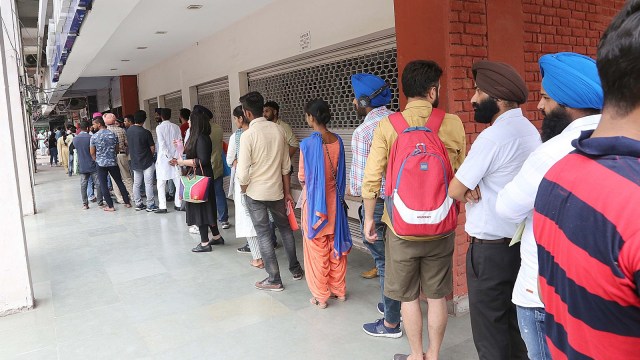
An in-depth study conducted by Punjab Agricultural University (PAU), Ludhiana, on the emigration patterns in Punjab has revealed that Canada continues to remain the most preferred destination for Punjabis followed by Dubai and Australia.
Canada (41.88%) was the most preferred destination for Punjabis followed by Dubai (16.25%), Australia (9.63%), Italy (5.54%), UK (3.49%), US (3.25%) and others (19.98%), the study found.
The study, the first of its kind covering 44 villages from 22 districts, has also found that 13.34% rural households had at least one family member abroad. Females (65%) outnumbered males (35%) in obtaining study visas as they were able to secure the required IELTS bands.
The groundbreaking research, “A Study on Overseas Migration from Rural Punjab: Trends, Causes, and Consequences,” led by Professor Shalini Sharma, Professor Manjeet Kaur, and Assistant Professor Amit Guleria from PAU’s Department of Economics and Sociology, reveals that the Majha region of Punjab, encompassing the border districts of Gurdaspur and Tarn Taran, has experienced the highest rate of migration at 20.51%. Following closely are Malwa at 14.28% and Doaba at 11.27%.
Noteworthy hotspots include Amritsar, Shaheed Bhagat Singh Nagar (Nawanshahr), Gurdaspur, and Ferozepur, all with migration rates surpassing 30%.
One of the researchers professor Manjeet Kaur said that study was conducted from 2021 to 2023 at the budget of Rs 2.04 lakh to “enumerate the extent of overseas migration in Punjab.”
“Of the total 9492 households in 44 selected villages across 22 districts, we interviewed 640 migrant households (MHs) and 660 non-migrant households (NMHs). A total of 831 migrants from 640 households have been covered in the study. The migration period considered for the study was 1990 to 2022. We found that 13.34% households have at least one migrant family member. It was inferred that migration witnessed a stark increase since 2016 i.e. 74 per cent of total emigration,” she said.
The study has also revealed the sad saga of the financial burden that families had to face to send their loved ones abroad. The study reveals that families have spent Rs 18-25 lakh each on study visa and up to Rs 4 lakh each on work visa, spouse visa or PR. Some also spent Rs 25 to 32.50 lakh on migrants who went by illegal means.
At least 19.38% of migrant families sold their assets, including land, plots/houses, topsoil, cars, gold, and tractors. The average value of assets sold by migrant households was estimated at Rs. 1.23 lakh per household. The analysis revealed that the preferred item to sell among all categories of migrant households was gold. The majority of low-caste, landless, and labour households with low income resorted to selling gold. Around 18 percent of small farm households and less than six percent of medium and large farm households sold land to send their wards abroad.
Of those who sold their gold assets, 28.42% were SCs, 35% were landless, 17% were small farmers and 32% had low income (less than Rs 2 lakh). The low income farmers also sold their tractors to send children abroad, reveals the study.
Going by the figures of assets sold by families to send their children abroad, it is estimated to be Rs 5636 crore for the entire state. The majority of low-caste, low-income, landless, and laborers migrant households sold houses and gold ornaments to meet the expenses of migration. About 56 per cent of households borrowed money for sending their wards abroad. The average amount borrowed by migrant households worked out to Rs 3.13 lakh per household. Of this, non-institutional borrowing constituted 38.8 per cent and institutional money formed 61.2 per cent. At the state level, about Rs 14,342 crore were borrowed for the purpose of migration,” said Kaur.
When asked about the reasons for migration, the people interviewed cited low income, lack of employment opportunities (72%), corruption and systemic problems (62%), drug prevalence (52%), social insecurity (50%), small land holdings (35%), landlessness (28%), and debt (24%)
The study also revealed that males, landless, minimally educated and SCs from Doaba emigrated to UAE on work visa, while Canada and Australia (via study visa) were the dream destinations for the young as well as Jatt Sikhs from all farm size categories from Majha and Malwa.
71.88% of migrant households and 52.88% of non-migrant households were engaged in agriculture. Among male migrants, 43.15% went on work and 33.73% on study visa while among female migrants 64.37% went on study visa and 14.98% on spouse visa.
At least 95% migrants and 91% families of migrants said they were satisfied with the decision to migrate abroad from Punjab of which 37% said they got better employment, 24% expressed happiness over raised standard of living and 19% were happy with better governance.
Besides finances, migration carried a huge social cost in the form of loneliness (52%), neglect of elderly (41%), indebtedness (38%), abandoned agriculture and parental occupation (30%), and sale of landholdings and assets (26%).
Among suggestions received to stop brain drain from Punjab, 96% said that the status of employment should be improved, 27% said that loopholes in the system should be plugged and citizens should be ensured safety, 21% said that agriculture should be made more viable and 8% demanded better education in government institutes.
The figures for the entire state, including Rs 14300 crore borrowed for migration and assets worth Rs 5,600 crore sold, have been calculated by multiplying average data with 4.58 lakh (i.e. 13.34% of total 34.34 lakh rural households in Punjab), said Kaur.
